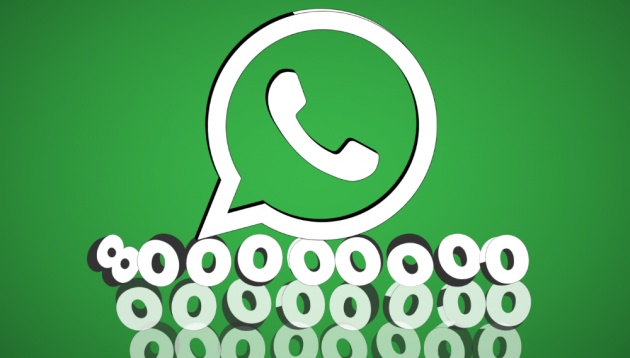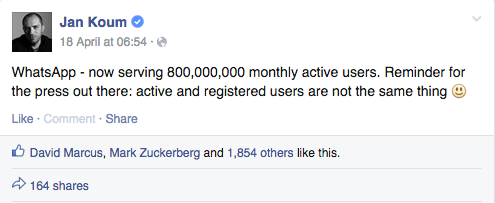
This week, WhatsApp passed a milestone when CEO Jan Koum revealed that it had broken 800 million active users. That’s quite something in this age, when the leading global social networks and Internet services are well established. Breaking into that club isn’t easy, but WhatsApp has done it — nearly doubling its user base over the past year, since it was acquired by Facebook for an eye-popping $19 billion.
Yet, impressive as those numbers are, there is something troubling about this new data point.
Here’s Koum’s Facebook post:

At this point, most people know the difference between these two metrics. Monthly active users is a more accurate way to measure the reach and engagement of a service — but it is far from definitive.
To suggest that MAUs provide a true picture of a business and its user base is at best naive, or at worst misleading.
“We aren’t giving any additional data beyond the 800M MAUs,” a WhatsApp spokesperson told TechCrunch after we got in touch to ask for more info.
Metrics Are Metrics
For example, I could open WhatsApp just once in a month — for five minutes over a 30-day period — and I’d be counted as one of its 800 million ‘active’ users. That’s more than a little off. (And I’m not even thinking about those who use the service ‘twice’ via dual SIM phones.)
Messaging apps are core services; they are meant to be used more regularly than once a month because we talk to our friends, families and colleagues on a daily basis.
A better metric to gauge WhatsApp’s traction might be the number of weekly or monthly users, messages sent between users, messages per user per day, etc.
That’s easy for me to say, of course. WhatsApp prefers to keep this data to itself. Which is fine — it is quite within its rights to do so. But professing that revealing MAU figures exposes the truth behind the numbers is plain false.
It isn’t just about quibbling over numbers; there’s an important business issue here. The next stage of messaging is rapidly coming, and it’s a time when the local network of a service is of critical importance.
Going Beyond Chat
There are only so many ways that you can monetize chat while maintaining the user experience. As Facebook showed when it launched its Messenger platform, the future is connecting services — such as payments, business-to-consumer communication and more. In Asia, commerce and online-to-offline services are increasingly a focus for messaging apps.
The critical fact here is the strength of a local network. It doesn’t matter how many users you have across the world. If you don’t have a solid base in a particular country, then roping in local service partners to build out the business is a challenge.
For example, Kakao Talk in Korea has fewer than 200 million registered users and probably under 100 million of them are active on a monthly basis.
Yet, in Korea, its app is installed on over 95 percent of smartphones. That makes launching a taxi-booking feature, payments and other services a no-brainer because retailers and others know there is a captive audience that they can tap right into.
Kakao has been profitable since 2013, and last year it merged with local internet giant Daum in a $3 billion deal. It did miss the global opportunity for messaging, but its Korean business is nonetheless evidence of where messaging is headed.
WhatsApp’s Challenges
WhatsApp has 800 million ‘monthly active users’ worldwide. We know that it is particularly huge in India, with over 70 million monthly active users, but it isn’t clear where else its network is strong with highly engaged users.
That’s important because in the future, if it looks to monetize beyond a $1 annual fee, it will need strength and depth in local markets to make its platform appealing.
It seems likely WhatsApp will win out in India and parts of Europe and the Middle East, but it has lost the top markets in Asia (China, Korea, Japan and Taiwan) and is up against a range of competitors in Southeast Asia and other parts of the world. The U.S. market is also hugely challenging given the high usage of iMessage, and competitors like Kik and Snapchat.
That’s a very different picture to “800 million monthly active users,”which implies world domination.
Another factor I’ve heard plenty of industry chatter about is that a large proportion of WhatsApp users are not on Android and iOS devices. Getting its service to market on such phones is a real testament to the engineering capabilities of WhatsApp — and its popularity in Africa and Latin America — but introducing additional services to these users on BlackBerry, Windows Phone or Symbian is technically challenging and probably not possible.
That’s another issue for WhatsApp to contend with as it looks to develop from a communications utility into a lucrative business.
So, while 800 million MAUs is an impressive statistic, remember that it is only that: just another statistic.



